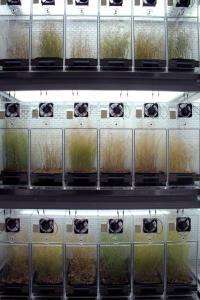Insects shape the genetic landscape through plant defenses

As restaurant patrons' diverse food preferences give rise to varied menu offerings, so plant-eating insects' preferences play an important role in maintaining and shaping the genetic variation of their host plants in a geographic area, reports an international team of researchers that includes a plant scientist at the University of California, Davis.
The new study, involving aphids and the broccoli-like research plant Arabidopsis thaliana, provides the first measureable evidence that this selective process is driven, in part, by the pressure that multiple natural enemies exert on plants by forcing them to create diverse natural defenses to avoid being eaten.
Findings from the study, conducted with researchers in Switzerland, Denmark and England, will appear in the Oct. 5 issue of the journal Science.
"Our data demonstrate that there is a link between the abundance of two types of aphids and the continental distribution of Arabidopsis plants that are genetically different in terms of the biochemicals they produce to defend against insect feeding," said UC Davis plant scientist Dan Kliebenstein.
His laboratory is examining the naturally occurring chemicals involved with plant defenses to better to understand their role in the environment and to explore their potential for improving human nutrition and fighting cancer.
Ecologists have theorized for decades that genetic change and variation within a plant or animal species is critical to enabling the species to survive such changing environmental conditions as the appearance of a new disease or pest.
They have documented that nonbiological changes, such as variations in climate and soil, can exert pressures that cause genetic variation within plant species. However there has been little evidence that biological forces, including insects feeding on plants or competition between plant species, can lead to genetic variation within a plant species across a large geographic area.
In the new study, the researchers first mapped the distribution of six different chemical profiles within Arabidopsis thaliana plants across Europe, each chemical profile controlled by the variation in three genes.
The mapping revealed a change in the function of one of these key genes across geographic areas; the gene changed from southwest to the northeast.
The researchers theorized that two aphid species—Brevicoryne brassicae and Lipaphis erysimi—were the likely causes of the geographic variation. Both are abundant in the regions and feed heavily on Arabidopsis and related plants.
The scientists then tapped data collected by British researchers for nearly 50 years on fluctuations in aphid populations in Europe. They found that distribution of the two aphids species of interest closely mirrored the geographic distribution of the different chemical types of Arabidopsis plants. One aphid preferred the southwestern chemical type while the other aphid preferred the northeastern chemical type.
The next step was to determine whether the similarity between the distribution patterns of the plants and the two aphid species was more than coincidental. To do this, the researchers observed what happened when the different aphids fed on five generations of experimentally raised Arabidopsis thaliana plants.
They confirmed that the plants were genetically adapting to the aphids, with each successive plant generation showing less damage from the feeding insects. A change in the genetic makeup of the plant populations specific to each aphid accompanied this trend—and the laboratory plants evolved in a way that tracked the geographic distribution of the two aphids and the plant chemical types.
The researchers also found that when faced with feeding by aphids, the faster-growing Arabidopsis plant types fared better in the laboratory, while the slowest-growing plant types actually went experimentally extinct.
"These data make it clear that even functionally similar plant-eating pests can affect the biochemical and genetic makeup of plant populations, playing a major role in shaping and refining the plant defenses in a natural community," Kliebenstein said.
Plant sciences have long been a strength at UC Davis, where for decades plant biologists have contributed to our understanding of how plants evolve, grow, fight infections and pests, respond to light, absorb nutrients from the soil and turn sunlight into sugars. Their discoveries have opened new avenues for developing crops that could grow under diverse environmental conditions.
More information: Tobias Züst, Christian Heichinger, Ueli Grossniklaus, Richard Harrington, Daniel J. Kliebenstein, Lindsay Turnbull. Natural enemies drive geographic variation in plant defenses. Science. October 5, 2012, doi: 10.1126/science.1226397
Journal information: Science
Provided by UC Davis


















